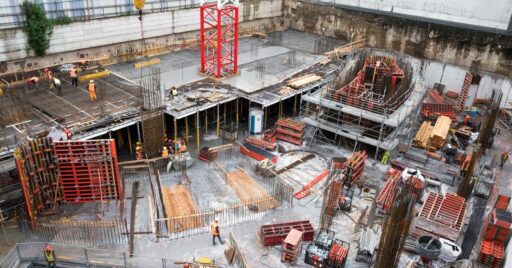In the evolving landscape of the construction industry, businesses face a myriad of challenges that can hinder growth and operational success. This article provides a deep dive into the insights from the Associated General Contractors (AGC) on how to navigate these industry challenges effectively. By understanding and implementing strategic approaches, fostering a culture of safety, embracing technological advancements, building a competitive edge, and addressing diversity and inclusion, construction businesses can transform obstacles into opportunities for innovation, sustainable growth, and long-term resilience.
Key Takeaways
- Strategic advocacy and leveraging legislative changes are crucial for addressing industry-wide challenges and securing infrastructure funding.
- A focus on mental health, safety awards, and hazard training underscores the importance of a comprehensive approach to safety and health in construction.
- Technological solutions are key to overcoming supply chain disruptions and enhancing workforce development amidst rapid industry digitization.
- Utilizing industry data for decision-making and risk management strategies can provide a significant competitive advantage in the construction sector.
- Implementing diversity and inclusion strategies not only supports workforce development but also ensures compliance with evolving legal and contractual frameworks.
Strategic Approaches to Industry Challenges

Advocacy Efforts and Legislative Impact
In the dynamic landscape of construction, advocacy efforts and legislative impact play a pivotal role in shaping the industry’s future. California contractors, for instance, must navigate regulatory changes like Assembly Bill 5, adapt to Federal Acquisition Regulations, leverage growth opportunities, enhance operations with technology, and comply with labor laws for successful operations.
The ability to influence policy and adapt to legislative changes is crucial for maintaining a competitive edge and ensuring compliance.
Key areas of focus for advocacy include Project Labor Agreements, the Davis-Bacon Act, and various tax and fiscal policies. These elements not only affect the day-to-day operations but also the strategic planning of construction firms:
- Understanding and influencing Project Labor Agreements
- Navigating the complexities of the Davis-Bacon Act
- Staying abreast of changes in tax and fiscal policy
By actively participating in advocacy, contractors can help shape the policies that impact their businesses and the industry at large.
Infrastructure Development and Funding
The construction industry is on the cusp of a significant upswing, with Deloitte industry experts forecasting a surge in activity by 2024. This optimistic outlook is largely fueled by federal initiatives, such as the Infrastructure Investment and Jobs Act, which are expected to catalyze growth across the sector. The Associated Builders and Contractors (ABC) echoes this sentiment, projecting not only an increase in construction projects but also in profitability and staffing levels.
With the right strategies in place, firms can capitalize on these upcoming opportunities to enhance their infrastructure development capabilities and secure funding that will propel their projects forward.
However, the industry must also prepare to navigate financial challenges that can arise, such as cash flow shortages and project delays, which can have serious implications on the overall cost and timeline of infrastructure projects. By staying informed and proactive, companies can mitigate these risks and maintain a competitive edge in the evolving construction landscape.
Innovations in Education and Research
The construction industry is witnessing a significant shift towards embracing real-time innovation and technological integration. This evolution necessitates a fresh approach to education and research, one that is closely aligned with industry needs and technological advancements.
The Center for Construction Innovation and Collaboration (CCIC) exemplifies this new direction. The CCIC works to define construction-related problems and address them with targeted research, while preparing students to work in the industry. These clearly defined goals ensure that the workforce is not only skilled but also adaptable to the ever-changing landscape of construction technology.
Embracing digital technologies and fostering a culture of innovation are crucial for adapting, thriving, and growing within the construction sector.
Key challenges such as resistance to change, lack of digital literacy, and uncertainty about the return on investment can be mitigated through continuous training programs. These programs are designed to enhance digital literacy and encourage strategic implementation of construction tech solutions.
Fostering a Culture of Safety and Health

Mental Health and Suicide Prevention Initiatives
The construction industry is increasingly recognizing the importance of mental health and the devastating impact of suicide among its workforce. Confronting these issues head-on is not only a moral imperative but also a strategic necessity for maintaining a healthy and productive work environment.
- Engagement & Wellbeing Consulting: Offering support and resources to employees.
- Clinical Consulting Services: Providing access to mental health professionals.
- Total Human Health Resources: Integrating mental health into overall employee wellness.
The commitment to mental health is a commitment to the very people who build our future. It is essential to see mental health become as much of a priority as physical safety in the construction industry.
Initiatives like the AGC-Autodesk Safety Harness Grant Program and the Hard Hats to Helmets campaign are examples of proactive steps being taken. These programs not only provide the necessary tools and equipment to ensure physical safety but also aim to address the psychological well-being of workers by promoting awareness and prevention strategies.
Recognition Programs and Safety Awards
Recognition programs play a pivotal role in promoting workplace safety and health in the construction industry. The acknowledgment of safety excellence not only motivates firms to maintain high standards but also sets benchmarks for others to aspire to. The Associated General Contractors (AGC) offers various awards, such as the Construction Safety Professional of the Year (CSPY), to honor those who have made significant contributions to safety in construction.
Recognition awards serve as a testament to a company’s commitment to safety and its success in implementing effective safety programs.
The following is a list of key recognition programs and safety awards within the industry:
- National Safety Excellence Award
- Safety Performance Report
- STEP Safety Management System
- Total Human Health
- Emergency Preparedness & Safety Resources
Winners of the prestigious CSPY award are celebrated at the AGC Construction Safety & Health Conference, highlighting the importance of leadership in safety.
Training for Hazard Awareness and Prevention
In the construction industry, training for hazard awareness and prevention is a cornerstone of maintaining a safe work environment. The 40-hour EM 385-1-1 Construction Safety Hazard Awareness course is a prime example of the resources available to equip workers with the knowledge they need to navigate potential hazards. This course provides an in-depth understanding of the EM385-1-1 standards, which are essential for compliance with USACE requirements.
Effective training programs are not just about meeting regulatory standards; they are about fostering a culture of safety that permeates every level of an organization.
To further enhance safety training, many organizations adopt a structured approach to learning. Below is a list of key components that are often included in comprehensive safety training initiatives:
- Root cause analysis to understand and mitigate risks
- Strategic planning to proactively address potential safety issues
- Cultivation of a learning culture that values continuous improvement
- Access to safety technology resources and emergency preparedness materials
By integrating these elements, companies can create robust training programs that not only comply with safety regulations but also contribute to the overall well-being of their workforce.
Embracing Technological Advancements

The Role of Advanced Technologies in Construction
The construction industry is undergoing a significant transformation, driven by the integration of advanced technologies. These innovations are not just modernizing processes but are also addressing the critical issue of labor shortages by enhancing productivity and efficiency.
- 3D printing
- Robotics
- Wearable safety sensors
- GPS technology
- Drones
- Dash cameras
- Self-driving vehicles
- Telematics
- Internet of Things (IoT)
Each of these technologies plays a pivotal role in automating tasks, improving safety measures, and reducing unnecessary costs. For instance, the use of drones for site surveying has drastically cut down the time and labor required for this task, while IoT devices are enabling real-time monitoring of equipment and materials.
By embracing these technological advancements, the construction sector can mitigate many of its longstanding challenges, turning them into opportunities for growth and innovation.
The rise of technology in construction also necessitates a shift in workforce skills. Investing in training and adaptability is crucial for companies to fully leverage the potential of these new tools and maintain a competitive edge in the evolving industry.
Navigating Supply Chain Disruptions with Tech Solutions
In the face of supply chain disruptions, the construction industry is turning to technology for resilience. Real-time tracking and forecasting through supply chain management software have become pivotal in mitigating delays and controlling costs. These tools enable companies to respond proactively to global events, transportation issues, and fluctuating demand.
- Challenge: Difficulty in obtaining materials.
- Main Causes: Global events, transportation issues, increased demand.
- Tech Solution: Supply chain management software.
By leveraging technology, construction firms can streamline procurement processes, ensuring that projects remain on schedule despite the unpredictable nature of supply chains.
The competitive advantage gained from successfully navigating these challenges is substantial. Firms that demonstrate adaptability and foresight in utilizing tech solutions not only overcome immediate hurdles but also position themselves as industry leaders, attracting new opportunities and partnerships.
Investing in Workforce Development and Training
The construction industry is recognizing the critical importance of investing in workforce development and training. This investment is not only about enhancing the skill set of the current workforce but also about attracting new talent to the field.
- Increasing outreach efforts at community events (e.g., high school job fairs, trade school forums) to encourage the next generation of construction workers.
- Leveraging upskilling and reskilling initiatives to continue educating current workers and build their professional abilities.
- Providing comprehensive and ongoing safety training to new and existing workers of all experience levels.
- Offering more competitive wages and benefits to retain and attract skilled labor.
The focus on continuous learning and improvement is essential for the industry’s sustainability and competitiveness. By fostering a culture of education, construction firms can ensure that their workforce is equipped with the latest knowledge and skills necessary to meet the demands of a rapidly evolving sector.
Building a Competitive Edge in Construction

Leveraging Industry Data for Strategic Decision Making
In the competitive landscape of construction, accessing industry-leading commercial construction data is crucial for contractors aiming to make informed decisions. This data provides a foundation for finding and bidding on projects, and it is essential for maximizing project success through project intelligence data and strategic networking.
As the industry continues to evolve, leveraging these insights will be crucial for companies aiming to enhance their sales strategies, capitalize on new opportunities, and maintain a competitive edge in the market.
The data-driven understanding of market research trends offers a roadmap for navigating the complexities of sales in the construction industry. It emphasizes the importance of strategic planning, innovation, and adaptability in achieving business objectives. By staying attuned to market demands and focusing on strategic planning, businesses within the construction industry can achieve sustained success.
Insight Spotlight:
- How to create a data-driven insight strategy
- Harnessing AI’s potential to accelerate the energy transition
- Planning for a century of maintenance in mine closures
- Ensuring a social licence for a sustainable waste future
Achieving Operational Success through Risk Management
In the construction industry, risk mitigation and planning are pivotal for maintaining a competitive edge. Engaging in root cause analysis and implementing effective solutions not only enhances an organization’s capabilities but also fosters a culture of continuous learning. By learning from past challenges, construction firms can anticipate potential issues, plan strategically, and proactively address risks in future projects.
Improved financial stability is a direct outcome of mitigating challenges related to budget overruns, the cost of materials, and unauthorized expenses. This stability provides a solid foundation for future projects and the flexibility to invest in innovation and growth.
Several trends are impacting the construction sector, and by tracking these developments, businesses can maintain long-term growth and operational success. It’s essential to connect with industry experts for additional risk management guidance to navigate the evolving landscape of construction risks effectively.
Cultivating Partnerships and Expanding Market Reach
In the competitive landscape of construction, cultivating partnerships and expanding market reach are pivotal for sustained growth. By forging strategic alliances, construction firms can access new markets, share resources, and enhance their service offerings. This collaborative approach not only diversifies risk but also amplifies the potential for innovation and market penetration.
For the enhancement of existing product lines, the focus on investment suggests a commitment to improving offerings and expanding market presence.
Strengthening stakeholder relationships is another cornerstone for expanding market reach. Seeking feedback and actively addressing concerns builds a network of trust, laying the groundwork for successful future collaborations. This proactive engagement with clients, subcontractors, and other stakeholders is a strategic endeavor, aimed at elevating how content resonates with the audience.
The following list encapsulates the core commitments construction firms should make to sustain and grow their businesses:
- Sustain and grow their businesses, financially and economically
- Offer market-competitive compensation, benefit, and retirement packages
- Commit to industry-leading safety
- Commit to workforce development, education, and creating career opportunities
- Commit to work environments that are inclusive and diverse
- Develop opportunities for their employees to achieve their career dreams
- Cultivate committed leadership
Risk mitigation and planning are integral to ensuring that these partnerships and market expansion efforts are sustainable and profitable in the long term.
Addressing the Evolving Landscape of Diversity and Inclusion

Implementing Diversity and Inclusion Strategies
In the quest to foster a more inclusive construction industry, implementing diversity and inclusion strategies is paramount. One effective approach is the adoption of blind recruitment practices, which aim to minimize bias by omitting personal identifiers from resumes and applications. This method ensures that the focus remains on the candidate’s skills and qualifications.
To truly embrace diversity, companies must look beyond hiring practices and cultivate an environment that supports and values varied perspectives. This includes offering market-competitive compensation and benefits, committing to workforce development, and creating career opportunities for all.
Here are some steps to consider in the implementation process:
- Review and revise job advertisements to ensure they are inclusive and welcoming to a diverse applicant pool.
- Establish mentorship programs that support underrepresented groups within the company.
- Conduct regular training sessions on diversity, equity, and inclusion for all employees.
- Set measurable goals for diversity and track progress over time.
Impact on Workforce Development
The construction industry is currently facing a significant workforce development challenge, with a retiring workforce and a widening generational gap. To address this, companies like Evans General Contractors are focusing on community support and innovative construction practices to attract and retain talent.
- Increasing outreach efforts at community events, such as high school job fairs and trade school forums, is crucial for encouraging the next generation of construction workers.
- Leveraging upskilling and reskilling initiatives is essential to continue educating current workers and build their professional abilities.
- Providing comprehensive and ongoing safety training ensures that new and existing workers of all experience levels maintain high standards of safety.
- Offering more competitive wages and benefits is a strategy to attract and retain skilled workers in a competitive market.
The need for skilled employees in construction has not changed, but the ability of organizations to meet this need is being tested. Upskilling the younger and emerging workforce is imperative to offset the challenges of an aging workforce and the skill shortage created by historically low unemployment and mega projects.
Organizations must also consider the impact of advanced technologies on workforce development. As the adoption of these technologies increases, the demand for candidates with the skills to utilize and drive such technologies will rise, further emphasizing the importance of investing in workforce training and development.
Legal Considerations and Contractual Compliance
In the construction industry, legal and contractual compliance is paramount to mitigate risks and ensure project success. Frequent changes in building codes, zoning laws, and safety regulations pose a significant challenge, often leading to potential legal and financial risks. Utilizing compliance management software has become a critical tool to stay updated on regulatory changes and maintain adherence to the latest legal requirements.
The importance of deal review cannot be overstated, as it ensures that every transaction reflects a keen awareness of the competitive landscape, aiming to maximize profitability and efficiency.
The following table outlines key resources provided by the Associated General Contractors to assist in managing legal considerations and contractual compliance:
| Resource Category | Examples |
|---|---|
| State Law Matrix | Contract Risk Management, Dispute Resolution and Mitigation |
| Deal Advisory | Business Transition Resources, External Audit Preparation |
| Risk Management | Annual Risk Conference, Crisis Response & Communication |
In addition to these resources, it is crucial for firms to engage in deal advisory, which includes services like forensic accounting, litigation support, and intellectual property consulting, to ensure that every aspect of a transaction is as advantageous as possible.
Conclusion
As we have explored throughout this article, the construction industry faces a myriad of challenges that require strategic attention and innovative solutions. From supply chain disruptions to the integration of advanced technologies, the Associated General Contractors (AGC) play a pivotal role in guiding the sector towards sustainable growth and operational success. By embracing industry priorities such as advocacy, infrastructure, education, safety, and workforce development, construction businesses can transform these challenges into competitive advantages. The insights provided here aim to empower industry leaders to navigate these hurdles with confidence, ensuring long-term resilience and leadership in the ever-evolving construction landscape. As we look ahead, staying informed and proactive will be key to maintaining momentum and achieving operational excellence in the face of adversity.
Frequently Asked Questions
What are the main priorities of the Associated General Contractors of America?
The main priorities include advocacy for construction industry interests, infrastructure development, education and research funding, safety and health initiatives, workforce development, and diversity and inclusion efforts.
How can addressing construction challenges benefit businesses in the long term?
Effectively addressing construction challenges not only resolves immediate issues but also lays the foundation for a resilient and successful future, providing a competitive advantage that attracts clients and positions companies as industry leaders.
What are the top challenges in construction for 2024?
The top challenges include navigating supply chain disruptions, adapting to advanced technologies, and implementing effective risk management strategies to maintain operational success.
How is the AGC supporting mental health and suicide prevention in the construction industry?
The AGC promotes mental health and suicide prevention through initiatives such as education and training programs, awareness campaigns, and providing resources to support the well-being of construction workers.
What role do advanced technologies play in the construction industry?
Advanced technologies are pivotal in enhancing efficiency, improving safety, and overcoming supply chain challenges. They also play a crucial role in workforce development and training.
How does the AGC assist in fostering diversity and inclusion within the construction sector?
The AGC assists by implementing diversity and inclusion strategies, providing education on legal considerations and contractual compliance, and supporting workforce development initiatives that promote a diverse and inclusive environment.





